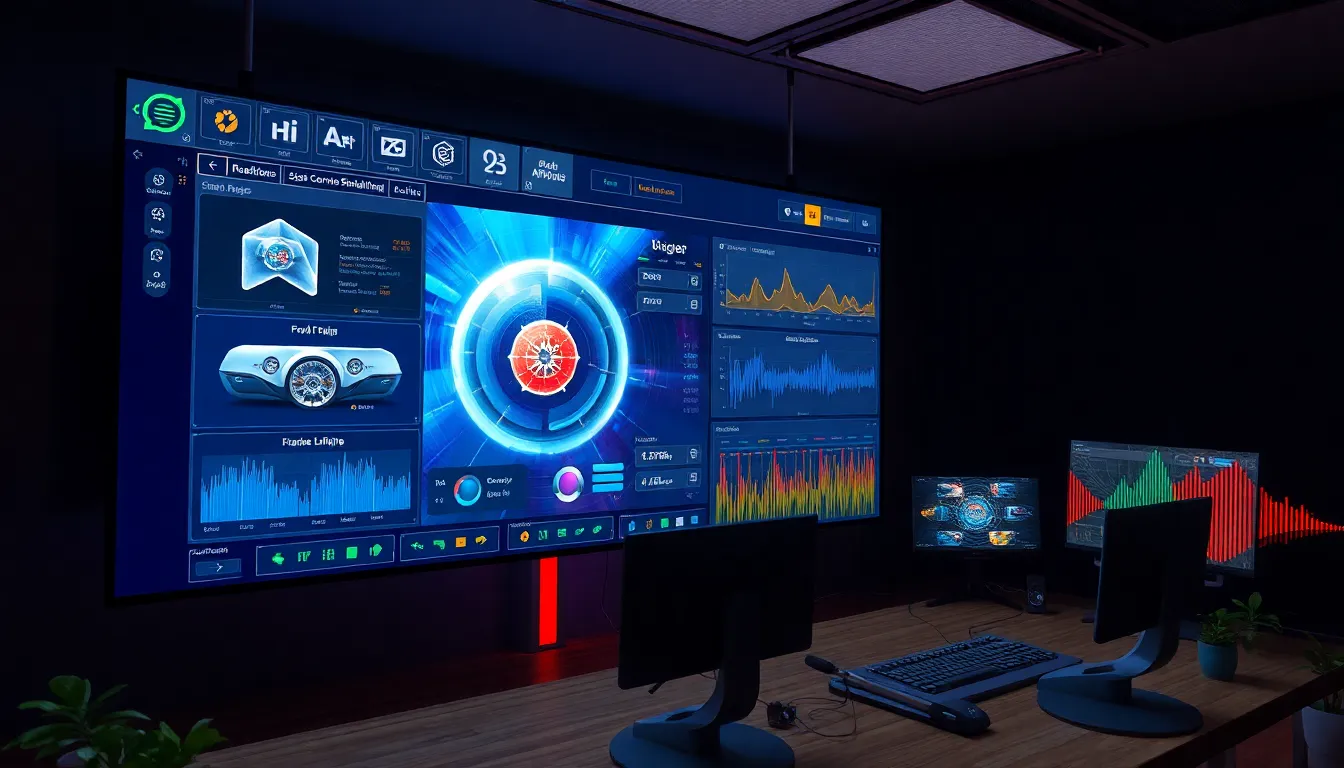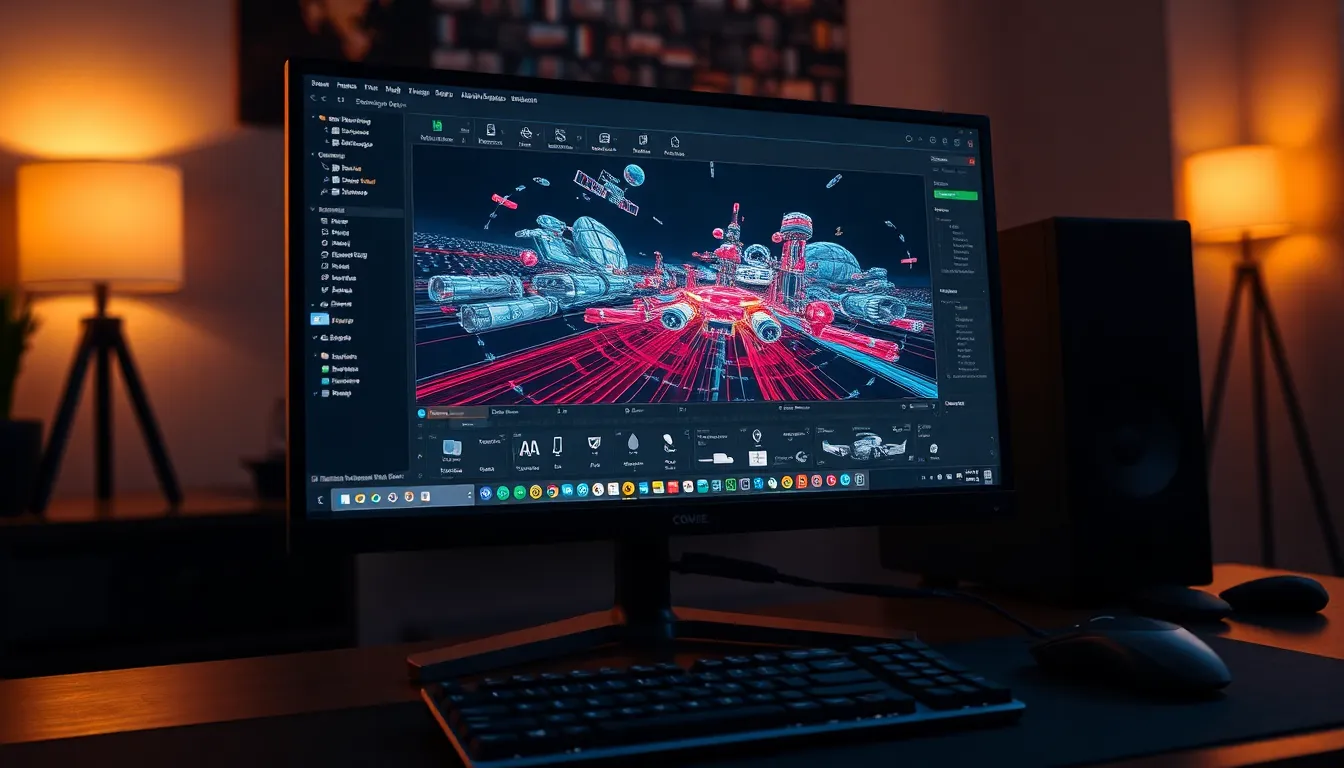In the dynamic world of video game development, gaming engine programming stands as a crucial pillar that brings virtual worlds to life. It’s the backbone that allows developers to create immersive experiences, from stunning graphics to complex gameplay mechanics. As technology advances, the demand for skilled programmers who can navigate these powerful engines continues to grow.
Understanding gaming engine programming isn’t just for seasoned developers; it’s essential for anyone looking to break into the industry. With a plethora of engines available, each offering unique features and capabilities, aspiring creators can harness these tools to turn their imaginative ideas into reality. Whether it’s building a simple mobile game or a sprawling open-world adventure, mastering the intricacies of gaming engines can set the stage for success in this ever-evolving field.
Table of Contents
ToggleOverview of Gaming Engine Programming
Gaming engine programming consists of creating software frameworks that facilitate video game development. These engines manage essential functions, such as graphics rendering, physics simulation, and sound processing. Programmers utilize engines to optimize workflows, enabling the efficient development of diverse game types, from 2D platformers to 3D first-person shooters.
Developers work with various gaming engines, including Unity, Unreal Engine, and Godot. Each engine features distinct programming languages and tools, tailored for specific game development needs. Unity, for example, primarily uses C# and supports both 2D and 3D game development. Unreal Engine employs C++ for high-performance graphics and complex systems, while Godot offers an intuitive scripting language called GDScript.
Understanding the architecture of gaming engines is crucial for effective programming. Common components include:
- Rendering Engine: Manages visual output, translating 3D models into a 2D display.
- Physics Engine: Simulates realistic movements and interactions between game objects.
- Audio Engine: Handles sound effects and background music, enriching user experience.
- Input Management: Captures player commands from various input devices, such as keyboards, mice, and controllers.
Developers must also prioritize performance optimization and user experience. Optimizing code and asset management improves frame rates and responsiveness. Effective collaboration with artists and designers ensures that programming aligns with the overall vision of the game.
With the gaming industry continuously evolving, the landscape of gaming engine programming remains dynamic. Staying current with industry trends, updates, and programming techniques enhances a developer’s skill set, providing a pathway to creating innovative gaming experiences.
Key Components of a Gaming Engine


Key components drive the functionality of gaming engines, each playing a crucial role in creating immersive experiences. The core elements include graphics rendering, physics simulation, and audio management.
Graphics Rendering
Graphics rendering involves converting 2D or 3D models into visual representations on the screen. This process includes handling lighting, shading, textures, and animations to create realistic environments and characters. Rendering engines support various techniques, such as rasterization and ray tracing, to achieve different visual styles. Popular graphics APIs like DirectX and OpenGL facilitate these processes, allowing developers to optimize visual fidelity and performance.
Physics Simulation
Physics simulation manages the behavior of objects within the game world, ensuring realistic interactions based on physical laws. This component includes collision detection, rigid body dynamics, and fluid dynamics. Engines utilize algorithms like the Verlet integration method or the Euler method to simulate motion and forces, enabling engaging player experiences. Accurate physics simulation enhances gameplay mechanics, making interactions intuitive and believable.
Audio Management
Audio management handles sound effects, music, and voice-overs to enhance player immersion. This component deals with audio mixing, spatialization, and environmental effects to ensure sounds align with the game’s context. Game engines often integrate middleware tools like FMOD or Wwise to provide advanced audio features, enabling developers to create dynamic soundscapes. Effective audio management contributes significantly to the emotional impact and atmosphere of the game.
Popular Gaming Engines
Several gaming engines are popular among developers, each offering unique capabilities and tools for creating engaging experiences. Below are details on three prominent engines in the industry.
Unity
Unity is a versatile gaming engine known for its user-friendly interface and extensive community support. It supports C# as its primary programming language, making it accessible for both beginners and experienced developers. Unity is widely used for 2D and 3D game development across various platforms, including mobile, desktop, and consoles. It features a robust asset store, allowing developers to purchase and share assets, plugins, and tools, facilitating quicker development cycles and innovation.
Unreal Engine
Unreal Engine stands out for its high-fidelity graphics and advanced rendering capabilities. Developed by Epic Games, it utilizes C++ for programming, offering powerful performance optimizations. Unreal Engine is ideal for developing complex games, including AAA titles and immersive virtual reality experiences. Its visual scripting tool, Blueprints, enables designers to create game logic without extensive coding knowledge. Unreal Engine’s marketplace also offers a wealth of resources, including assets, plugins, and project templates to expedite game development.
Godot
Godot is an open-source gaming engine gaining traction for its lightweight design and flexibility. It supports GDScript, a Python-like language, along with C# and VisualScript. Godot excels in 2D game development, though it also supports 3D projects. Its scene system allows for efficient organization and reuse of elements, simplifying the development process. As an open-source engine, Godot fosters a collaborative environment where developers can contribute to its growth and share their advancements with the community.
Best Practices in Gaming Engine Programming
Implementing best practices in gaming engine programming enhances performance and scalability. Developers can achieve greater efficiency and maintainability by adhering to specific principles.
Code Optimization
Code optimization involves refining code for improved performance and reduced resource consumption. Developers should prioritize the following techniques:
- Profiling: Use profiling tools to identify bottlenecks in performance. Profiling helps pinpoint slow functions or memory issues that may arise during game execution.
- Efficient Algorithms: Implement algorithms with low computational complexity to ensure smoother gameplay, particularly in real-time applications.
- Data Structures: Select appropriate data structures for storing game data. Utilizing structures like spatial partitioning trees can enhance performance by reducing the number of collision checks.
- Memory Management: Optimize memory usage by minimizing allocations during runtime. Preallocated memory pools can help reduce fragmentation and garbage collection overhead.
- Conditional Updates: Update only necessary game objects per frame to reduce processing time. Implement techniques like object pooling to reuse objects rather than frequently instantiating and destroying them.
Modular Design
- Separation of Concerns: Divide code into distinct modules that handle specific tasks, such as rendering, physics, and input management. This separation simplifies maintenance and enhances collaboration between teams.
- Reusable Components: Create components that can easily integrate into multiple game projects. Reusable components reduce redundant work and encourage the sharing of best practices across projects.
- Interface-Driven Development: Employ interfaces to define expected behaviors for components. Interfaces enhance adaptability, allowing developers to swap implementations without altering dependent code.
- Version Control: Utilize version control systems to manage changes and facilitate collaboration among team members. Version control helps track modifications, making it easier to revert to previous states when needed.
- Testing Frameworks: Integrate testing frameworks to ensure that individual modules function correctly. Automated unit tests catch bugs early, leading to more reliable and stable game builds.
Future Trends in Gaming Engine Development
Gaming engine development is rapidly evolving, influenced by technological advancements and changing player expectations. Developers must stay informed of emerging trends that shape the future of gaming.
- Real-Time Ray Tracing
Real-time ray tracing enhances visual fidelity through advanced simulations of light behavior, providing realistic shadows and reflections. As graphics hardware becomes more powerful, implementation of ray tracing in engines like Unreal Engine and Unity becomes standard practice.
- Artificial Intelligence Integration
Artificial Intelligence (AI) plays a pivotal role in creating dynamic gaming experiences. It influences NPC behavior, game difficulty scaling, and procedural content generation. Developers increasingly adopt AI tools for improving player interactions and enhancing overall gameplay.
- Cloud Gaming Technology
Cloud gaming enables streaming games without high-end hardware. Technologies like Google Stadia and NVIDIA GeForce Now expand access and reduce barriers to entry. Gaming engines must adapt to support cloud infrastructure efficiently, ensuring seamless performance across various devices.
- Virtual and Augmented Reality
Virtual (VR) and augmented reality (AR) continue to rise, pushing engines to support immersive environments. Early adopters leverage engines like Unity for developing VR experiences, while tools for AR applications gain traction in game development, enhancing interactive storytelling.
- Cross-Platform Development
Cross-platform development remains critical, allowing seamless play across devices. Engines that support extensive platform compatibility, including mobile, console, and PC, enhance audience reach. Developers focus on optimizing performance and user experience across numerous platforms.
- Open-Source Engine Growth
Open-source engines like Godot gain popularity due to their accessibility and community-driven development. These engines encourage collaboration, enabling developers to customize engines to fit specific needs while fostering innovative game projects.
- Procedural Generation Techniques
Procedural generation enhances content diversity in games, creating expansive worlds with varying challenges. Developers apply algorithms to generate environments, quest lines, and character designs, thereby saving resources while enriching player experiences.
- Blockchain Integration
Blockchain technology gains importance in gaming, facilitating secure transactions and enabling player ownership of in-game assets. As developers explore decentralized systems, gaming engines adapt to integrate these features, presenting new avenues for monetization and player engagement.
Monitoring these trends will empower developers to create pioneering and engaging gaming experiences, optimizing output and reaching broader audiences.


